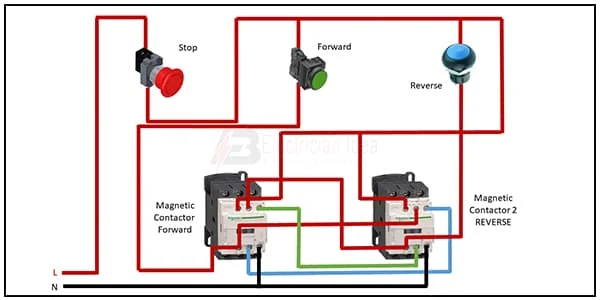Contactor Interlocking Wiring
This diagram shows how to make Contactor Interlocking Wiring. This article is about contact interlock. Here, you will know how to operate the contact interlock. This article also includes a contact interlock circuit and connection diagram. Contact combination systems find applications in motor starters (star-delta), power control circuits, power switch circuits, etc. When an electrical circuit has two magnetic contactors, and there only one magnetic contactor needs to be turned on, at the same time then there need the interlocking system is used for this circuit.
Diagram of Contactor Interlocking Wiring
Components Need for this Project:
You can get the components from any of the sites below:
Read Also:
Components used to make the Contactor Interlocking Wiring:
01. Magnetic Contactor
 |
| Fig 2: Magnetic Contactor |
02. Push Switch
 |
| Fig 3: Push Switch |
Thank You for visiting the website. Keep visiting for more Updates.
Frequently Asked Questions
Electrical interlock on wire mesh. An interlock device is designed to allow a generator to provide backup power in such a way that it (a) prevents main and generator power from being connected at the same time, and (b) allows circuit diagram breakers to operate normally without interference in the event of the overload condition.
Interlocking was a safety measure designed to prevent signals and points or switches from being changed in an improper sequence. For example, interlocking would prevent the signal from being changed to indicate a diverging route, unless the corresponding points or switches had been changed first.
Pushbutton interlocking doesn't require the motor coils to be disengaged before the reversing direction because the normally closed forward contacts were in series with the normally open reverse contacts, or vice-versa. Pushing one button simultaneously disengages one coil while starting the other.
When a bicycle is properly built, all of it is separate parts interlock. The parts of the machine have to interlock for it to work well: gears must be interlocked with each other, for example. You could also interlock fingers with another person, holding hands so that they're laced together.
Interlock devices offer several advantages for industrial safety, such as reducing human error or negligence, enhancing compliance with safety regulations and standards, improving productivity or efficiency, and preventing unauthorized or unqualified personnel from tampering with and operating the machine.


Post a Comment
Do leave your comments